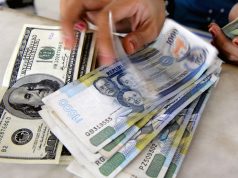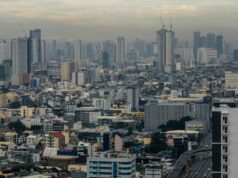Trade remains a drag in April as exports drop to lowest level in nearly 2 years
By Jochebed B. Gonzales, Senior Researcher
THE country’s trade deficit expanded in April on account of declining merchandise exports and a double-digit surge in inbound shipments, the government reported on Friday.
Preliminary results from the Philippine Statistics Authority (PSA) showed merchandise exports declining 8.5% to $5.115 billion in April, lower than the 6.8% contraction posted in March and a far cry from the 30.4% growth in April 2017. This was the worst turnout since the 10.9% decrease logged in July 2016.
The latest merchandise export figure brought year-to-date receipts to $20.955 billion, down 6.2% from $22.344 billion in the same four months last year and below the government’s 10% target for 2018.
By major type of goods, manufactured goods — which make up 84.2% of the country’s total export goods — slid 6.3% to $4.306 billion.
“The decline was tempered by a 5.5% expansion in exports of electronic products,” the National Economic and Development Authority (NEDA) said in a separate statement. Exports of electronic products, according to PSA, was valued at $2.975 billion, representing 58.2% share to total receipts in April.
“The increase in exports of electronic manufactures was led by faster growth of semiconductors (5.3%), compared with the 3.1% uptick recorded in the previous month, reflecting the global trend as chip sales worldwide continued to grow at a double-digit pace,” it added.
Agro-based and mineral products also fell by 35.9% and 24.7%, respectively, to $270.702 million and $316.268 million.
The country’s biggest agricultural exports, coconut oil and banana, dropped by 23.9% and 45.4%, respectively, to $79.690 million and $61.837 million.
Security Bank Corp. economist Angelo B. Taningco attributed the slump in exports to domestic inflation, which has been rising sharply since January this year.
“I think the export decline may have been influenced by domestic inflation rising much faster than in our export markets, making our locally-made products not as competitive internationally,” he said.
“Moreover, there might be supply disruptions in certain agro-based products that have reduced their surplus levels and curtailed their export supply,” Mr. Taningco added.
Guian Angelo S. Dumalagan, market economist at Land Bank of the Philippines (LANDBANK), was of the same view: “The decline in exports of agro-based products can be attributed to weather disturbances. The major agricultural products affected were coconuts, bananas, mangoes, and pineapples,” he said.
Philippine Exporters Confederation, Inc. (PHILEXPORT) president Sergio R. Ortiz-Luis, Jr. said that the demand abroad is high especially for agriculture products “but that production is not enough, as what we have been complaining.”
DEFICIT WIDENS
“Strong imports and weak exports combine to widen the trade gap,” said ING Bank N.V. Manila Branch senior economist Jose Mario I. Cuyegkeng.
“Financing the wider trade deficit remains a challenge since a modest 4% to 5% overseas worker remittance growth this year would still be inadequate,” he added.
For April, the country’s trade deficit increased to $3.615 billion from $1.554 billion a year ago as import payments increased 22.2% to $8.729 billion during the month, faster than the 0.3% growth seen in March and 4% in April 2017.
Year-to-date, the country’s trade balance posted a $12.200 billion deficit, much bigger than the $7.656 billion shortfall during 2017’s comparable four months.
For imports, year-to-date growth is 10.5%, a few points shy of the government’s 11% target.
Comprising 37.2% of the total import bill in April, the value of imported raw materials and intermediate goods increased 11.8% to $3.251 billion. Capital goods, which accounted 36.9%, rose 29.3% to $3.217 billion.
Consumer goods, with 16% share, climbed 29.9% to $1.397 billion, while mineral fuels, lubricants and related materials picked up 27.1% to $808.687 million.
“The strong import demand for capital goods was due to buoyant business investment and infrastructure spending. Moreover, importation of consumer goods was vibrant on the back of healthy household consumption,” said Security Bank’s Mr. Taningco.
In a statement, Socioeconomic Planning Secretary Ernesto M. Pernia said the economy’s import performance this year is “encouraging,” but “much has to be done to create an environment that is necessary for exporters to thrive.”
Mr. Pernia, who is also NEDA’s director-general, cited the signing of the Ease of Doing Business Act of 2018 into law as “a step in the right direction.”
The ease of doing business law, known as Republic Act (RA) 11032, amends and expands RA 9485 or the Anti-Red Tape Act of 2007. Among its salient features are the streamlining of procedures, the shortening of processing time for government transactions, and creating a business portal to receive and obtain data involving business-related transactions.
Mr. Pernia likewise mentioned the launch of the single-window electronic trade-facilitation platform, TradeNet, which is linked to the Association of Southeast Asian Nations (ASEAN) member-countries’ respective electronic trade gateways — allowing the electronic exchange of border documents such as import and export permits and other certifications.
“Seizing the benefits of existing free trade agreements (FTAs) and forging new ties are equally important to expand the market for exports. To make FTAs more beneficial, the government needs to continue to encourage exporters to familiarize themselves with the proper tariff classification of products to find the lowest applicable tariffs as well as apply the rules of origin to avail of zero or lower tariff rates,” he said.
OUTLOOK
The period of trade deficits may not be going anytime soon, according to the economists interviewed.
Security Bank’s Mr. Taningco said exports may begin to rebound in the coming months, but also noted the country may see bigger deficits.
“It seems the export sector may be positioned for a gradual recovery in the very near term, especially once domestic supply normalizes and inflation decelerates,” he said. “Nevertheless, I still foresee a wider trade deficit this year, and therefore will likely have a negative contribution to GDP (gross domestic product) growth.”
For ING Bank’s Mr. Cuyegkeng: “Exports’ near term outlook remains dreary with base effects working against the sector after last year’s rebound. We expect this year’s trade deficit to be $6-8 billion wider than last year’s trade deficit of $27.4 billion.”
LANDBANK’s Mr. Dumalagan said the country’s trade balance “is likely to remain in deficit amid expectations of higher imports of capital goods.”
He noted, however, that while higher trade deficits provide a drag to the calculation of economic output, “it is not totally bad for the economy as an investment-led increase in imports could set the stage for stronger economic growth in the future.”
Hong Kong is the Philippines’ top export market in April with a 16.4% market share at $837.76 million, followed by the United States’ 15.4% ($789.54 million) and Japan’s 13.8% ($704.47 million) market shares.
Meanwhile, China was the country’s top source of imports with a 20.1% share in April ($1.753 billion), followed by the 11% market shares of South Korea ($958.48 million) and Japan ($958.19 million).



